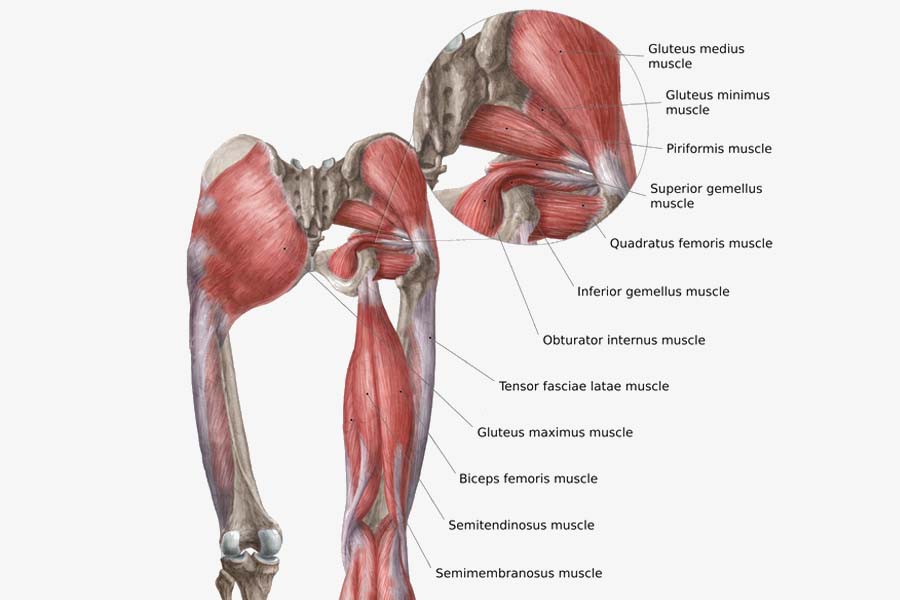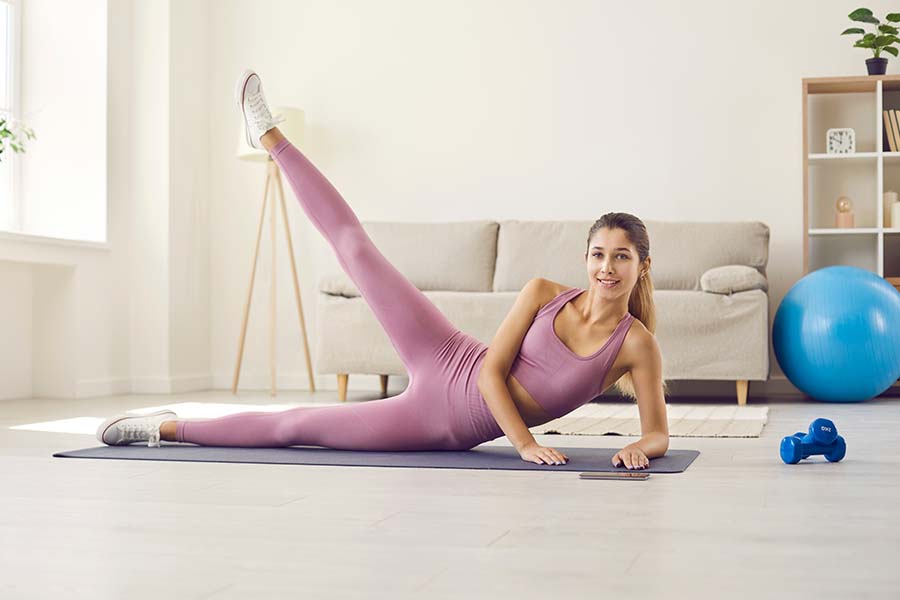Have you ever suffered excruciating pain in your hip that even moving an inch seemed impossible? Maybe you've had a backache that just won't go away. Or is your knee joint giving you another level of anxiety? Whatever the reason may be, you are not alone!
Hundreds of people suffer from hip pain, untoned back, improper form, knee pain, and other related issues. So what is causing all these problems?
Weak hip abductor muscles, in simpler words, weak hip muscles, are one of the reasons behind your stumbled walk, bad posture, and knee pain. Yes, you heard that right!
Most people don't think about their hip muscles very often, even though, the hips are a vitally important body part responsible for a wide range of movements.
Strong hip muscles help us to walk, run, and jump. They also provide stability and support for the lower back and unstable pelvis.
So why do we so often neglect our hips? Part of the issue may be that we can't see them. Our hip muscles are hidden beneath our skin, so we're not always aware of how they function.
Another reason may be that we simply don't think about them until something goes wrong. When our hips are healthy, they usually work without any problems.
So next time you go for a run or a hike, take a moment to appreciate your hip muscles! Thank them for all the excellent work they do to keep you moving. That being said, let’s move to the actual subject of the article.
You may have guessed it already, but for those still confused, we’ll help you train and strengthen your hip muscles through effective hip abduction exercises.
Related Article: Preventing Back Pain: 10 Tips to Promoting a Healthy Spine
What Do Your Hip Abductors Do?
Hip abductors are a group of muscles located on the outside of your hip. They work together to move your leg out to the side and away from the body, which is known as abduction
The main muscle in this group is the gluteus medius, which is why strong hip abductors are often referred to as having "strong glutes."
The hip abductors are important for stabilizing your pelvis and keeping your legs from collapsing inward when you walk or run. They also play a role in helping you lift your leg up and out to the side (like doing a side kick).
Strong hip abductors can help prevent injuries to the knee and ankle, and they can also help improve your overall balance and coordination.
Anatomy of Hip Abductor Muscles

There are two types of hip abductors, primary and secondary. The primary hip abductor muscles are a group of three muscles that work together to move the leg away from the body.
The Gluteus Medius
The largest and most powerful of the hip abductors is the gluteus medius. It originates on the outer surface of the ilium and inserts on the greater trochanter of the femur. The gluteus medius muscle helps stabilize the pelvis during walking and running.
The Gluteus Minimus
The gluteus minimus is a smaller muscle that originates on the ilium's outer surface. It inserts on the greater trochanter of the femur, just below the gluteus medius. The gluteus minimus works with the gluteus medius to abduct and rotate the leg.
The Tensor Fasciae Latae
The tensor fasciae latae is a long, thin muscle that runs along the outside of the thigh. It originates on the iliac crest and inserts on the iliotibial band, a thick band of connective tissue that runs down the length of the thigh. The tensor fasciae latae helps stabilize the knee joint and assists in hip abduction.
Together, these three muscles work to move the leg out to the side and keep the pelvis stable during movement.
The secondary hip abductors comprise the following muscles:
Piriformis
The piriformis is a small muscle in the buttocks that externally rotate the hip and helps stabilize the hip joint. The sciatic nerve, the largest nerve in the body, runs through or near the piriformis muscle. In some people, the muscle can irritate the sciatic nerve, causing pain that radiates down the leg, known as sciatica.
Sartorius
It is a long, thin muscle that extends from the upper thigh to the lower shin. It is one of the four muscles that make up the quadriceps and is responsible for knee flexion and hip abduction.
The sartorius also assists in keeping the knee aligned when walking or running. It is used extensively in bicycling, dancing, and swimming. The sartorius is a crucial muscle for sitting cross-legged.
Gluteus Maximas (Superior Fibers)
The superior fiber of the gluteus maximus is a secondary hip abductor, which helps move the leg away from the body besides knee and hip stabilization. It is the most essential of the gluteal muscles located on the hip joint’s posterior.
Now that our introductory biology class is over, let’s move to the principal thing; hip abductor exercises.
Related Article: Quad Destroyer Workout Plan: 12 Sets of Squats Workout
Hip Abductor Exercises
When it comes to strengthening the hips, a few hip abduction exercises can help work the muscles outside the hip, including the gluteus medius and minimus.
One of the best things about these hip abduction exercises is that they can be done anywhere, even if you don't have access to a gym or equipment.
Some of these exercises are listed down below:
Standing Hip Abduction

- Stand with your feet hip-width apart and your arms at your sides.
- Keeping your core engaged, slowly lift your leg to the side, maintaining a tall posture throughout the movement.
- Keep your pelvis level as you move your leg up, and focus on using your glute muscles to control the motion.
- Return to the starting position and repeat on the other side.
As you become more comfortable with the movement, you can increase the range of motion by lifting your leg higher or taking larger steps to the side. You can also add resistance by holding dumbbells in each hand.
Lying Abduction

- Lie on your side with your legs stacked up on each other and your head resting on your bottom arm.
- Slowly lift your top leg to make a 45-degree angle.
- Keep your hips level, and do not roll forward or backward.
- Hold this position for a count of five, then slowly lower your leg.
- Repeat this 10 times before switching to the other side.
Clamshell Raise

- Lie on your side with your knees bent and your feet together.
- Raise your left knee to a maximum of 12 inches in a 1-2-Up count (or the maximal range of motion without experiencing any pain).
- After pausing for one second at the top, slowly drop the leg to the count of 1-2-3-Down.
- To complete one set, perform this exercise up to 10 times on each leg.
- After taking a 30-second break, finish the second set.
Resistance Band Walking

- Attach a resistance band to each ankle. Ensure the band is snuggly fitted, so it doesn't slip during your walk.
- Start walking with knees slightly bent, keeping tension on the bands as you step forward. You should feel the resistance in your legs as you walk.
- To increase the intensity of your workout, try walking faster or adding hills or inclines to your route.
Water Walking

There is less stress on the hips in the water and perhaps more mobility for people with joint issues or limited range of motion. That is why water walking is one of the best hip abduction exercises.
Also, people healing from accidents or hip joint injuries may benefit from other water exercises, such as water aerobics. Swimming pool exercises are a fantastic technique for developing hip abductor strength with little effort.
Exercises like these can strengthen your hip abductor muscles and lower your risk of injury. These workouts are pretty beneficial for older people or athletes.
Related Article: How Can You Switch From Weightlifting to Resistance Bands
Benefits
Hip abduction exercises help strengthen the whole hip region and improve flexibility. These muscles can regain some range of motion with the help of strengthening and stretching, which lessens pain and reduces the risk of potential injury.
The hip abductors can be strengthened to aid with injury recovery. Strong abductors, for instance, have been reported to aid in the healing after a meniscus knee injury. Increasing hip strength may enhance the stability and strength of the knee and hip joints.
According to 2020 research, hip abductor exercises may help with knee osteoarthritis symptoms. These activities offer a secure and drug-free alternative for treating arthritic pain.
According to Jessa Olson (professional trainer), these exercises reduce knee valgus, improve muscle activation and performance, and treat pain. Knee valgus, as she defines it, is when your knees bend inward and it occurs "when you lack hip strength.”
This condition is sometimes known as collapsing the knee or getting knock-kneed. While some people only experience this condition when engaging in weight-bearing activities or workouts like squats, others have it all the time.
And practicing the above-mentioned exercises may help reduce knee valgus.
Considerations and Risks
The key is to perform exercises with proper form. If you don't follow the steps correctly, then your workout can lead to overstraining of the hip muscles and even injuries in the worst-case scenarios.
These exercises are safe for most people, but anyone experiencing discomfort during the execution of these movements should stop. Those looking to strengthen their hip abductors may consult a doctor before proceeding due to caution about certain exercises being too difficult or painful in specific areas.
Some exercises may need balancing on one leg or walking with a resistance band. If you're working towards improving your balance, try floor-based workouts instead.
The Bottom Line
So there you have it! Everything you need to know about the hip abductor muscles, exercises that tone them, and how to stay safe while working out. Try to focus on proper form and technique when performing these exercises, and if you experience any pain or discomfort, stop immediately.
Finally, always seek medical assistance before starting any new exercise program. We hope this article has been helpful and that you enjoy incorporating these exercises into your workout routine. Thanks for reading!
FAQs
1. Do I need to train abductors?
Yes, you must train abductors like your hamstrings, quads, chest, back, or your biceps and triceps to avoid an imbalance that could result in damage.
2. Where are hip abductors located?
They are located on the lateral thigh.
3. How many hip abductors should I do?
Do 2-3 sets of 10-12 reps.
4. What is the cause of abductor pain?
There are multiple causes of abductor pain, including bad posture, sports involving continuous jumping, and abductor muscle injuries.
5. How many hip abductors are there?
There are 3 hip abductors; gluteus maximus, gluteus minimus, and tensor fasciae latae.
Reading List
Article Sources
- Kak, Hwang-Bo, et al. “The Effect of Hip Abductor Exercise on Muscle Strength and Trunk stability after an Injury of the Lower Extremities.” Journal of Physical Therapy Science, vol. 28, no. 3, Mar. 2016, pp. 932–35. PubMed Central, https://doi.org/10.1589/jpts.28.932.
- Lubahn, Amanda J., et al. “HIP MUSCLE ACTIVATION AND KNEE FRONTAL PLANE MOTION DURING WEIGHT BEARING THERAPEUTIC EXERCISES.” International Journal of Sports Physical Therapy, vol. 6, no. 2, June 2011, pp. 92–103. PubMed Central, https://www.ncbi.nlm.nih.gov/pmc/articles/PMC3109897/.
- Mansfield, Paul Jackson, and Donald A. Neumann. “Chapter 9 - Structure and Function of the Hip.” Essentials of Kinesiology for the Physical Therapist Assistant (Third Edition), edited by Paul Jackson Mansfield and Donald A. Neumann, Mosby, 2019, pp. 233–77. ScienceDirect, https://doi.org/10.1016/B978-0-323-54498-6.00009-6.
- Yuenyongviwat, Varah, et al. “Effect of Hip Abductor Strengthening Exercises in Knee Osteoarthritis: A Randomized Controlled Trial.” BMC Musculoskeletal Disorders, vol. 21, no. 1, May 2020, p. 284. BioMed Central, https://doi.org/10.1186/s12891-020-03316-z.











